
The Business of Fashion
Agenda-setting intelligence, analysis and advice for the global fashion community.

Agenda-setting intelligence, analysis and advice for the global fashion community.
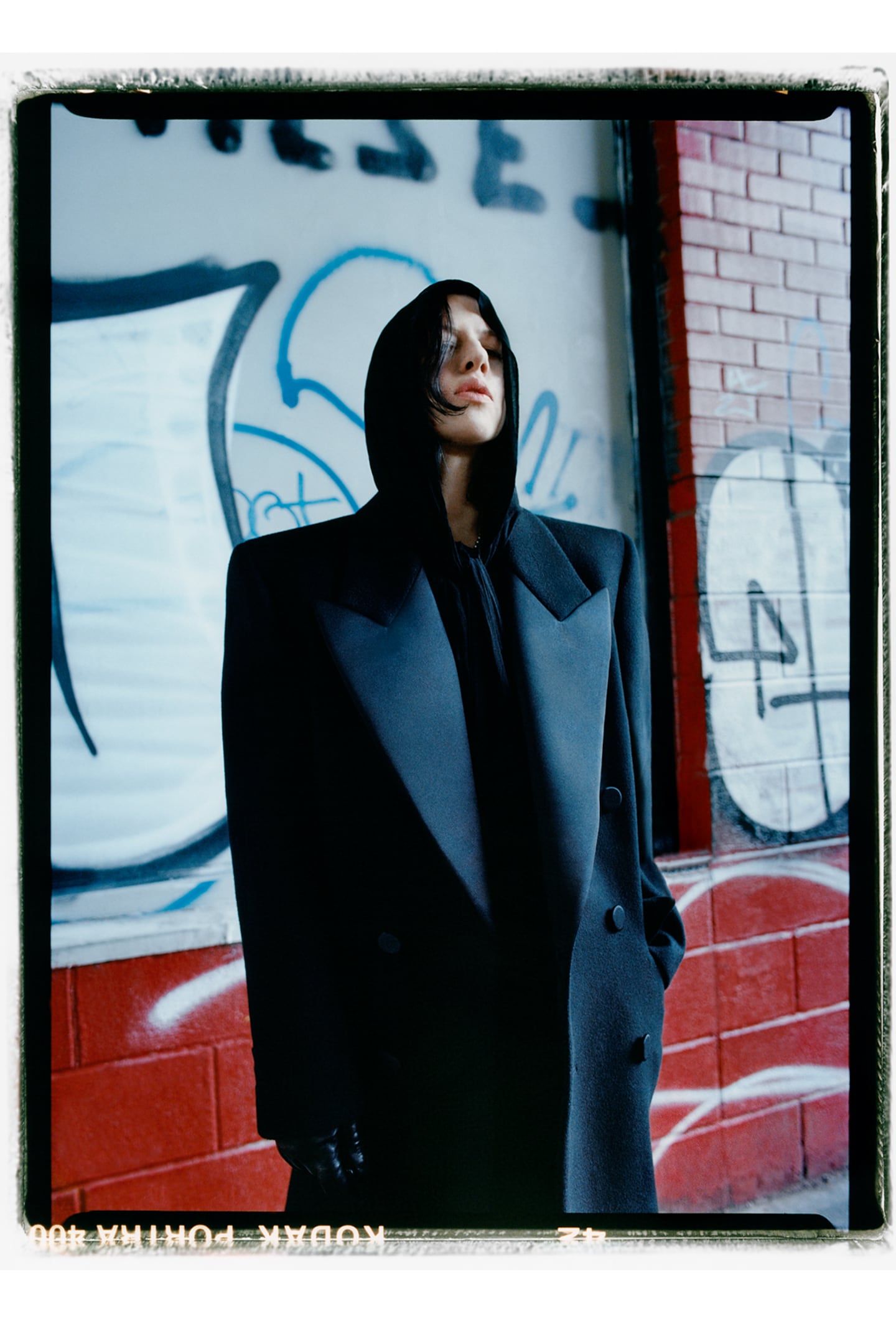
Anne Imhof reclines on cushions in the airy studio at her house in Berlin’s Kreuzberg as she eyeballs me across the ether. There are guitars propped against the wall, and an art experiment in progress on the large table in the middle of the room. The relaxed, almost domestic setting is a surprise. Maybe it’s the sunshine pouring through the huge windows.
Imhof’s reputation for hardcore performance art is rooted in dark, disturbing pieces. With their size, noise, huge casts and the incredible tension they create, not to mention their duration, they are operatic in their intensity, like a 21st century Götterdämmerung.
Imhof isn’t partial to the Wagner comparison, but the composer’s concept of the Gesamtkunstwerk, the total art work that makes use of many mediums, touches on the scale of her ambitions. Size has always mattered to Imhof. In 2016, she won a prize from the National Gallery in Berlin. “You could choose a space, and I wanted the big space that was in the entry hall of an old railway station. I wasn’t so sure I could handle it but I wanted to prove to myself that I was able to create something big.” Imhof signposted her intention by labelling the piece “opera.” Its actual title was Angst. She created the soundtrack, and cast old friends, fellow students from art school, a handful of dancers who had recently left the Ballet Frankfurt where they’d been working with choreographic genius William Forsythe.
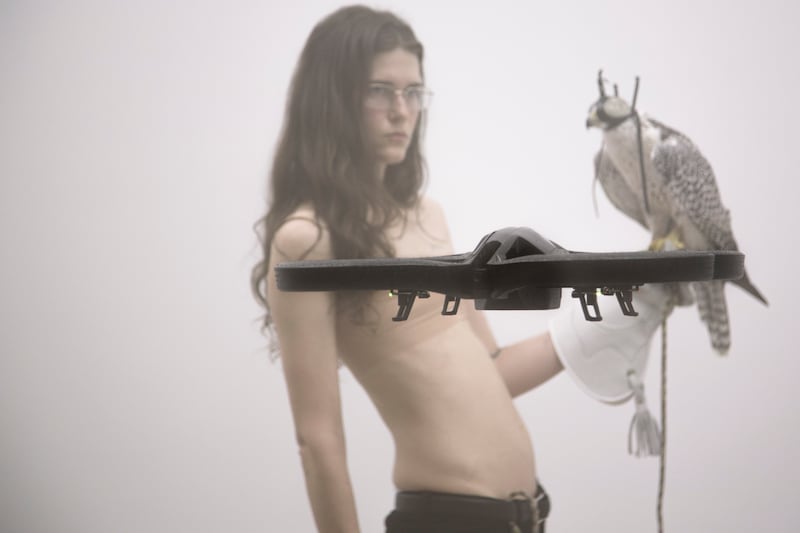
Angst proved the prototype for everything that came after. She believes she was able to make “something big” because “it was kind of a superpower to have this extreme rapport and intimacy” between the performers. They looked “real,” like a gang of people hanging out, doing stuff they might do in their own lives. “There were situations that I wanted to be in, and I didn’t want them to end.”
ADVERTISEMENT
The piece was also significant because it marked the first time she and Eliza Douglas, her new partner at the time, collaborated on costumes, sourced from Douglas’ collection of metal band T-shirts. Imhof describes herself as a teenage nerd. “I didn’t even really know about punk rock till I was 21.” (She is now 45.) She was living in a squat in Frankfurt when a friend taught her to play guitar and introduced her to riot grrrl. Another friend turned her onto American hardcore, music she’d missed growing up in a small town in Germany. Then she met Douglas, a revelation, who’d been in that scene in New York. Friends had told Imhof about “this hot new American” who was at the school she’d just graduated from. “They said, ‘Oh, you have to meet her, you’ll love her,’ and that was the case actually. We lined up really well because somehow we knew the same things but from a totally different perspective.”
Imhof made her next piece, Faust, for the German Pavilion at the 57th Venice Biennale in 2017. “I wanted it to be about vanitas so we were looking for T-shirts with skulls. Eliza had these metal t-shirts with writing on the back which integrated perfectly. She and I created this kind of reference system that was incredibly nurturing for us. So it was not really a costume. I wanted it to feel good to the people that were wearing it so it was always up to them to decide with us what they would wear. And they brought their own stuff.”
Faust was the first time Imhof made actual merchandise for a show. “There was a silkscreen in the studio, and we started printing Faust T-shirts on the floor, and then we made bomber jackets and it looked cool, so we printed Faust on the track suits that people in the performance wore,” she says. “And after that, we made T-shirts for each show, with the name of the show. It was Eliza pushing for that.”

But EMO, her most recent show, at the Sprüth Magers Gallery in Los Angeles, is something new for Imhof. As of July 6, the show’s merchandise — hoodies, T-shirts, bombers, caps — was made available for purchase at Dover Street Market. “Sometimes you don’t think about these things so specifically as a plan or a strategy,” Imhof says. “They just happen. It wasn’t a plan that the merchandise that I made for the EMO show became a collection. Like Dover Street Market wasn’t so much a thing I was aiming for. Still, it was also a place where I went to get inspired and look for things even though I couldn’t afford them.”
The EMO line is a collaboration with Reference Studios’ Mumi Haiati and ex-032c fashion director Marc Goehring. There was no live element to the EMO exhibition, so the merchandise wasn’t worn by Imhof’s performers. Instead, the visuals that adorn the pieces were derived from the images in the show: the raised middle finger, skeletal; the satanic clown; the turtle with the vape mounted on its shell, an echo of Rage, one of her first pieces, in which the performers puffed on vapes they plucked off the backs of the turtles that were rambling round. “It was very slow, that piece,” Imhof remembers wryly. Still, the turtles lingered as a favourite in a career which has seen her cast Dobermans and falcons.
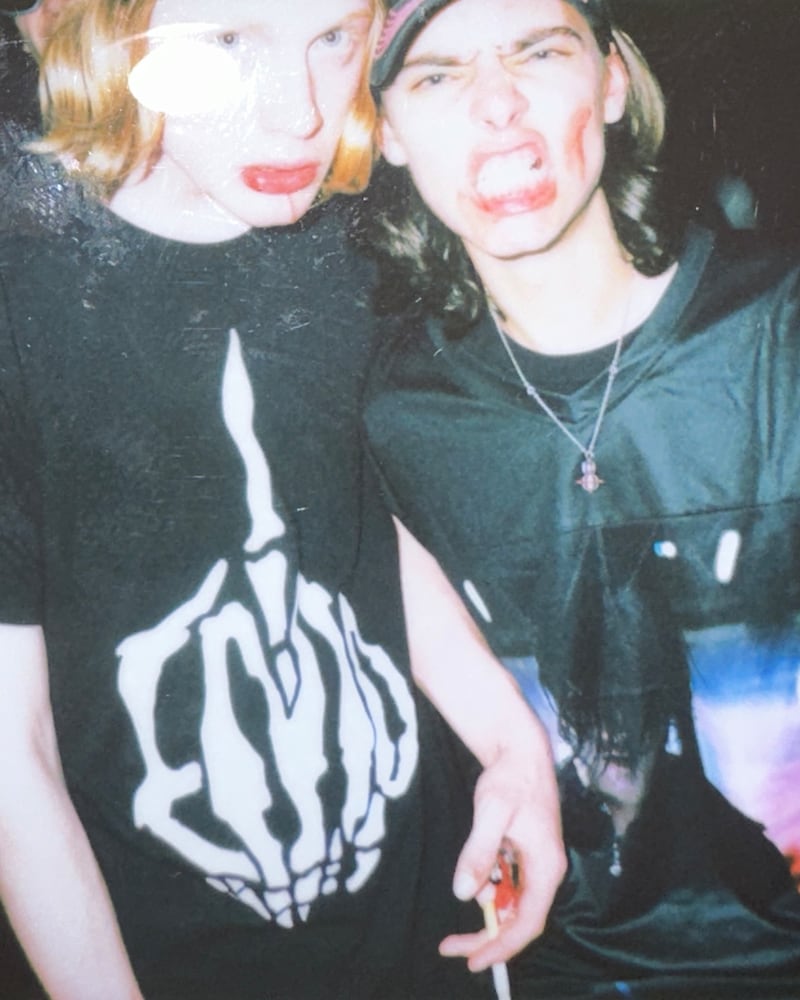
The EMO lettering emblazoned on the collection is something Imhof doodled one day; then she decided she wanted to make paintings with it. “I’m very interested in surfaces in the way I’m doing my paintings,” she says. “A T-shirt is also a surface you can put things on, and somehow the two worked very well together. What I put on a painting is what I put on a T-shirt. I like sacrificing my precious art practice. It poses the question, ‘Is that devaluing anything?’ I don’t really put something high or low. It just feels pretty much the same. It’s about people seeing it in some way or another, and building a relationship with it.”
The fact that she is even thinking about selling clothes in a retail temple like Dover Street Market raises interesting issues for Imhof. She insists, for instance, that what she loves about her live performances is that there is no physical takeaway. “Nothing you can possess. Even the photograph you make right now is more like a proof for yourself that you’ve been there.” But those photos exist on Instagram and gather weight as more and more people photograph the same thing. “It becomes iconic because people want to be part of that very collective moment,” Imhof says. “And that’s something that I think is very relevant for the idea of fashion. You create a language of togetherness with words or images or with what you wear, and then it becomes a world, or a universe, somehow, and you move inside of that. And that’s a bit like the live moment, because everything can happen in there.”

Imhof talks about “the weird presence of history” in Berlin: layered and heavy. She agrees there’s a fascination with the authoritarian in her work, coupled with a strong sense of isolation. “I have to deal with a sort of inner ‘torn-ness’ towards the country I’m living in and its history. Even saying where I come from, there’s this ‘torn-ness’ inside and I’m not proud. And when you grow up, like I did, in a small town as a queer person, there is a certain solitude coming with that, and then my way of being an artist and so early in my career doing the German Pavilion at the Venice Biennale, having this national pavilion — which is a Fascist building — as an exhibition space and having to deal with it where you can almost not say the name of your country without a certain shiver. You know, it was quite an Auseinandersetzung, a heavy thing to deal with.”
ADVERTISEMENT
The giants of contemporary German art, like Gerhard Richter, Anselm Kiefer and Georg Baselitz, have, of course, been confronting this challenge for decades. “It’s pretty hard to not be impressed by them because there’s a generation of teachers that confront you with them,” says Imhof. “And that’s what you have to deal with as much as with the history of your country. And Richter is pretty much the artistic icon from this generation. I find it amazing how he is always navigating the personal with the universal, putting the abstraction against the figuration. But he was also the figure that I had to somehow overcome as a young artist doing the German pavilion by myself.” In 2017, when Imhof won the Biennale’s Golden Lion Award for “Best National Participation” with Faust, there were no congratulations forthcoming from Germany’s art world heavyweights. She laughs it off. “Maybe they had a fear they would lose something.”
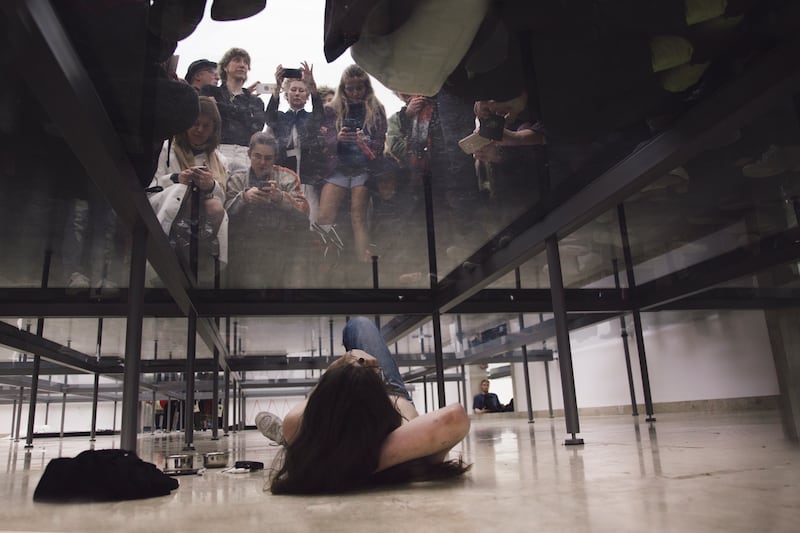
The interplay of dominance and submission that is physically present in everything Imhof does could easily be applied to the fashion industry. “I’m interested in images of power,” she says. “The idea of who’s the one who leads and who’s the one who is following, who’s the one who is looked at, and the one who’s looking.” During her shows, she directs her performers via their mobile phones, almost like painting with people, or a hybrid of art and moviemaking. “It is image-making for sure,” she agrees. Obviously, there is randomness in this approach. “It emerges almost by itself and then I can see if something’s good or bad. It’s important that there is the aspect of a mistake or accident or something that is unpredicted and that you leave space for it. And there’s the moment where you want to control things, because then you’re safe. But when you’re not safe, that’s the moment where something can actually happen and when you can be good. You have to dare to do that. It’s doing things in a way that they become so dangerous and forceful for me that I can’t escape doing the right thing or going where it’s deep and dark and unknown. And that’s where the new lies.”
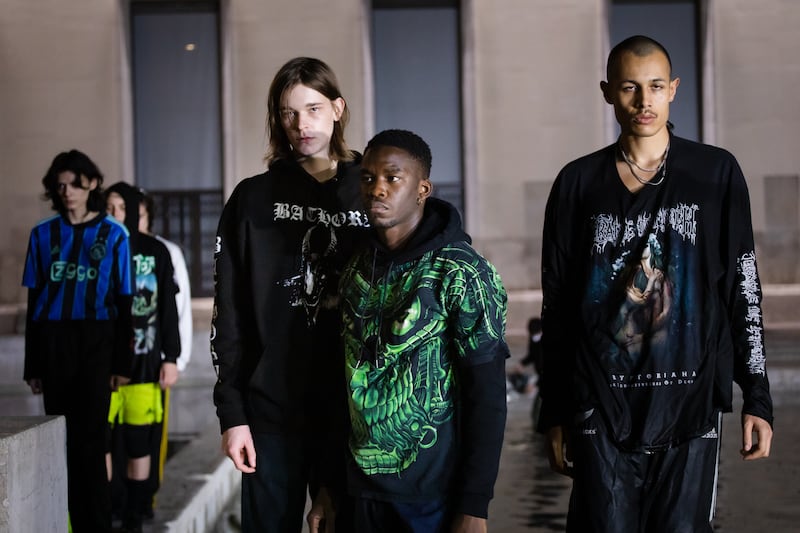
Anyone who has experienced an Imhof piece live will appreciate what she is talking about. The screaming, the brutality, the listlessness — “zombie expressionism” one critic called it, embodied by the bruised, bloodied young people in the EMO promo shots — generate an unsettling tension in the audience. But when her safe place is that, when she herself concedes that she is kind of immune to the disturbing nature of her own work, what could possibly propel her into the unknown? Is fashion a likely candidate? “I think more often now about things that are pop,” she says. “I want to go there because I’m not in that. It’s more about accessibility. My T-shirts are hanging in Dover Street Market. People will see them who have never heard of my work because they’re not in the art world. I find this interesting where something can go when you give access to it in a different way.”
She isn’t at all bothered that the fashion world will likely see her label as another incarnation of the heavy metal merch, with its goth-struck-by-lightning lettering, that is already a feature at Dover Street Market. She claims she admires fashion designers for their resilience. “Like Rick [Owens] and Michèle [Lamy]. It feels almost stoic how they’re doing it. And Virgil [Abloh] was very dear to me, how he was carrying a lot and also being careless, and there was this perfect mixture of the two things. He brought so much pop into fashion in a different way. It was something other than asking pop stars to pose for you.”
Demna has been in Imhof’s world since Eliza Douglas opened in his first show for Balenciaga, in 2016, when Imhof was making Angst. “There was admiration and friendship but we didn’t talk at length about fashion.” One obvious benchmark for her Dover Street project is Los Angeles artist Sterling Ruby and his fashion label S.R. Studio LA, not least because he is also represented by Sprüth Magers. “I’ve seen his things,” Imhof says. “There was this wave of artists doing real fashion-like approaches, with fashion shows and fashion lines. Not like Susan Cianciola who did it in the other direction, but art going into fashion. It’s more a flirtation, I think. I really like to think about fashion, see it, wear it, but I don’t want to claim I could do a fashion line. That’s something else. I do merchandise for my shows.”
“But it’s good to take a step out of the art world once in a while,” she acknowledges. “I can make more decisions. What do I do? Why do I do it? How do I involve my audience? That’s what I’m working on.” And yes, Imhof considers her merch one such step out. When she returns to the art world, her next big project involves an avatar. I’m already on edge.
Willy Vanderperre speaks to Tim Blanks on more than 30 years of fashion photography and his life-long fixation with youth culture.
Next week, MoMu, Antwerp’s fashion museum, will unveil a major exhibition celebrating the work of Belgian photographer Willy Vanderperre.
In an exclusive extract from her new memoir ‘How to Make Herself Agreeable to Everyone’ the model and activist examines the dark side of the industry — and her complicity in it.
Brand architect and art director joins BoF founder and editor-in-chief Imran Amed to discuss the philosophy that underpins his groundbreaking retail and hospitality concepts.